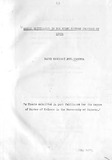| dc.description.abstract | Brucellosis is an important worldwide Zoonosis which causes abortions and infertility in animals and a debilitating disease in humans. The disease has a wide host range comprising humans, domestic and wild animals. The animal world acts as the reservoir for human infection Brucella abortus, Brucella melitenais Brucella suis , Brucella ovis and Brucella can is are important pathogens while Brucella neotomae has not been associated with any specific disease.
Animal brucellosis is widely distributed in Kenya with the highest incidence occuring in areas where extensive animal husbandry is practised and animal populations are high such as North Eastern Province, Masailand, Nyanza Province and Eastern Province.
Reports of Brucella isolations are few with only three reports from North Eastern Province. The few serological surveys carried out in North Eastern Province have been limited utilizing one test at a time and one or two animal species. None of these investigations included camels which fire an important source of meat and milk besides being an important means of transport in the province. Recently, clinical cases of brucellosis .In
both humans and animals have been reported by the veterinary and medical authorities in the province (Razil, personal communication, 1975).
A serological survey of cattle, sheep, goats and camels has been done to get an indication of the prevalence of brucellosis in the area. Seven hundred serum samples comprising of 174 camel sera, 220 bovine sera, 145 caprine sera and 161 ovine sera were analysed for Brucella antibodies using Rose bengal plate test (RBPT), serum agglutination test (SAT) and the complement fixation test (CRT). A high reactor rate was found in all the species tested. SAT and CRT reactors occured in approximately equal proportions in RBPT positive and RBPT negative sera. SAT and CRT were found to jack more positives than RBPT in camels. There was no significant difference between SAT and CRT. RBPT was found to pick more positives than SAT and CRT in bovine, and caprine sera. In ovine sera, RBPT and SAT
v/ere found to pick more positives than CRT with no significant difference between RBPT and SAT. This is the first brucellosis investigation to include camels in Kenya end a close relationship has been found between
the reactor rate in camels and that found in cattle, sheep, and goats.
In this study a high reactor rate was found,
A study of the literature has shown the epidemiological significance of wild animals especially those of the two families - Bovidae and Carnivora in brucellosis, Interspecies transmission has been reported (FA0/V7H0
Brucellosis Committee Report, 1971; Salem, 1975),
Due to the above reasons it is suggested that any meaningful control and/or eradication programme must involve all the four domestic species and the main wildlife species. It is recommended that a study should be undertaken to establish whether Brucella abortus S19 vaccine might be useful in camels in view of the importance of these animals for food and transport and epidemiology of brucellosis in North Eastern
Province | |

